Honolulu Volcanics
The Honolulu Volcanics are a group of volcanoes which form a volcanic field on the island of Oahu, Hawaii, more specifically in that island's southeastern sector and in the city of Honolulu from Pearl Harbor to the Mokapu Peninsula. It is part of the rejuvenated stage of Hawaiian volcanic activity, which occurred after the main stage of volcanic activity that on Oahu built the Koʻolau volcano. These volcanoes formed through dominantly explosive eruptions and gave rise to cinder cones, lava flows, tuff cones and volcanic islands. Among these are well known landmarks such as Diamond Head and Punchbowl Crater.
| Honolulu Volcanics | |
|---|---|
Topography of southeastern Oahu | |
| Highest point | |
| Coordinates | 21.37°N 157.8°W [1] |
| Geography | |
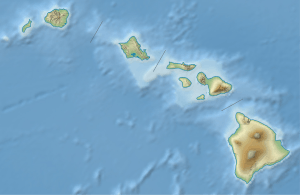 Honolulu Volcanics | |
Volcanic activity began less than one million years ago and occurred at between 40 and 30 separate volcanic vents, some of which are submarine. Sea level varied during the activity of the volcanic field, and some volcanic eruptions have been dated through correlation with individual sea level fluctuations. The field erupted various kinds of lavas of mostly basaltic type with a high content of xenoliths. During eruptions, ascending magma often underwent interactions with water and thus caused steam explosions and the formation of particular volcanic structures such as tuff cones. The last eruption took place 35,000 or 76,000 years ago and future hazardous eruptions are possible.
Geography and geomorphology
The Honolulu Volcanics are a series of volcanoes in the southeastern sector of Oahu[2] and includes dykes, lava flows, spatter cones,[3] tephra deposits,[4] tuff cones,[3] and mesas where the surrounding terrain has been eroded away.[5] Vents span the area southeast of a line between Mokapu Peninsula and Pearl Harbor, and extend from the ridges of Koʻolau volcano to below sea level and to the coast plain of southern Oahu.[6]
The system takes its name from Honolulu, the capital of Hawaii,[7] as craters are scattered in and around the city.[8] The volcanic system includes well-known landmarks of Honolulu such as Diamond Head, Koko Head, Punchbowl Crater,[3] Rabbit Island, Tantalus,[9] Hanauma Bay (notable as a snorkeling site)[10] and the Mokapu Peninsula,[11] which is the location of Marine Corps Base Hawaii.[12] The United States military has made use of some of the volcanic islands that were formed by the Honolulu Volcanics.[13] The Koko area is designated as the Koko Head Regional Park[14] and Hanauma Bay is also a state park.[15] Parts of this system are among the best known volcanic vents of Hawaii.[16]
About 30-40 vents have been identified.[17] Most cinder cones on Oahu are quite large, over 76 metres (250 ft) high and up to 0.80 kilometres (0.5 mi) wide.[18] Some of the lava flows filled deep valleys cut into the older Koʻolau volcano[19] and displaced streams that previously ran through these valleys; for example, water passing over a lava flow in Kamanaiki Valley forms a waterfall.[20] Together with sediments coming down from the mountains and coral reef growth, the deposits of the Honolulu Volcanics have formed the coastal plain on which the city of Honolulu and military installations are built.[21]
The vents of the Honolulu Volcanics follow northeastward-trending[6] alignments that are at right angles to the rift zone of the Koʻolau volcano.[22] From northwest to southeast these are the Haiku Rift, the Tantalus Rift, the Kaimuki/Kaau Rift and the Koko Head/Koko Rift.[23][24] It is not clear whether these alignments are in any way related to the structure of the previous Koʻolau volcano, instead of being controlled by the crust of the Pacific Ocean,[6] but the trends along the Koko and Tantalus Rifts are parallel to that of the flexural arch[lower-alpha 1] of Hawaii Island.[26] There is also a hypothetical "Diamond Head fault" that may be associated with earthquakes on Oahu that occurred in 1948, 1951 and 1961–1981, but it is not parallel to these alignments and its very existence is questionable.[27]
Submarine vents are also known,[28] including a 300-metre (980 ft) high solitary cone with two ridges off northeast Oahu, which is covered by pillow lavas and volcaniclastic sediments.[29] Additional cones are found off the southwestern extension of the Koko Rift[30] where they are situated on a southwestward extending ridge. Another set of submarine vents is found south of Diamond Head.[31] It was once proposed that some seamounts (underwater mountains) off northeastern Oahu such as Tuscaloosa Seamount are related to the volcanic series;[32] today however they are considered to be fragments of the giant Nuanuu landslide off northeastern Oahu.[33]
.jpg) Hanauma Bay in the foreground, Koko is in the middle
Hanauma Bay in the foreground, Koko is in the middle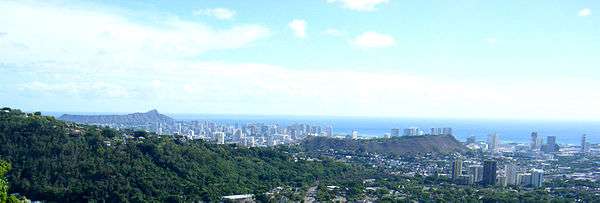 Diamond Head to the left, Punchbowl in the middle
Diamond Head to the left, Punchbowl in the middle
Description of individual volcanoes
Most of the present-day shoreline of Hawaii Kai was formed by Honolulu Volcanics;[34] the Kuapa Pond is a leftover lake between the new shoreline and the old shoreline of the Koʻolau volcano.[35] The volcanic vents there include Koko Head, the Hanauma Bay craters, Kahauloa crater bay, a wave-eroded cone, Koko Crater and Kalama cinder cone;[34] Koko Head cones are heavily eroded, and the sea has broken into one of the cones, exposing its structure in outcrops.[36] Koko Head is the largest cone of the Honolulu Volcanics[37] and the crater of Koko Crater is about 1 kilometre (0.62 mi) wide.[38] Hanauma Bay close to Kalanianaole Highway is located 13 kilometres (8.1 mi) east of Honolulu[39] and is a 0.4 by 0.8 kilometres (0.25 mi × 0.50 mi) large, 18 metres (59 ft) deep[40] compound crater[41]/tuff cone[42] with several associated dykes and lava flows-[43] It was breached by the sea[42] and coral reefs grow within it.[44] Together with Kahauloa and Kalama all these vents form the Koko Rift.[28] Farther northeast lie the Kaupo lava flow and the islands of Kaohikaipu and Mānana;[45] all these are also in the Koko Rift.[46]
Diamond Head is a 1,700-metre (5,600 ft) (rim-to-rim) wide[38] typical tuff cone with a wide and not overly deep crater that forms a prominent promontory east of Honolulu.[36] Inland from Diamond Head lie the Kaimuki and Mauumae cones,[47] which appear to come from a shared fissure.[36] Mauumae features a lava flow[48] and Kaimuki is an unusual lava cone with a summit crater.[49] Its slopes are gentle and lava ponded against topographical obstacles.[50] The Kaimuki and Kaau cinder cones together with Mauumae and Diamond Head form the Kaau or Kaimuki rift zone;[51] the Kaau crater lies close to the crest of the Koʻolau Range and is filled by a swamp that drains into Waimao stream.[52] Punchbowl Crater rises north of[53] and at the centre of Honolulu and is a good outlook to the city and its surroundings.[7]
The Mokapu peninsula was formed by Honolulu Volcanics and includes the three volcanic vents of Puu Hawaiiloa, Pyramid Rock and Ulapau Head; additional vents form islets off the peninsula,[54] such as Moku Manu[55] and Mokolea rock. Puu Hawaiiloa is a cinder cone in the middle of the peninsula,[56] Pyramid Rock at the northwestern tip[57] is deeply eroded and probably the oldest vent in the peninsula, and Ulapau Head is a crater that was breached by the sea[56] and of which only a crescent-like western part remains.[58]
Salt Lake Crater[59] contains a salt lake and is located east from Pearl Harbor;[60] the salt lake formed when salty groundwater seeped into the crater and was concentrated by evaporation.[61] A cluster of additional older vents known as Aliamanu, Makalapa, Aliamanu School Cone, Moanalua Cone, Akulikuli Vent and Wiliki Cone are associated with Salt Lake Crater.[62] The Salt Lake Tuff is associated with these craters and covers an area of at least 13 square kilometres (5 sq mi);[63] Honolulu International Airport and Hickham Air Force Base lie south and southwest from the vents respectively.[64] Some of these vents have been identified as maars.[65]
Geology
The Honolulu Volcanics developed on the 2.3 million year old Koʻolau Volcanic Series,[2] which forms the core of eastern Oahu and extends underwater far from the shore.[3] Like other Hawaiian volcanoes Koʻolau is a shield volcano that grew through lava flows erupted from a rift system with a central caldera, although a large section of the volcano has sunk below sea level. This volcano constitutes the tholeiitic stage of Hawaiian volcanism,[66] and developed possibly during Miocene to Pleistocene time.[39] Before Koʻolau volcano was active, between 3.5 and 2.74 million years ago, Waianae volcano formed the western part of Oahu.[67] Koʻolau volcano appears to be unrelated to the Honolulu Volcanics,[6] which are considered to be a separate volcanic system;[54] sometimes the "Kokohead Volcanics" are split off from the Honolulu Volcanics.[68]
The Honolulu Volcanics constitute a late stage of volcanism[66] which in Hawaii is known as the rejuvenated stage[69] and the third stage of a typical Hawaiian volcano.[19] They have a much smaller volume than the Koʻolau volcano[22] even though their lava flows are usually thicker;[70] the unconformity that separates the Honolulu Volcanics from the Koʻolau Volcanic Series was already recognized in the 19th century.[71]
As Hawaiian volcanoes grow, they start to sink under their weight. As volcanism moves along the Hawaiian chain, the Hawaiian Arch moves behind the volcanism at a distance of several hundred kilometres, and appears to have passed under Oahu in geologically recent times. The tectonic effect of the Hawaiian Arch passing under the island may be responsible for the onset of Honolulu Volcanics volcanism, as well as of the Koloa Volcanics on Kauai and perhaps for future volcanism on Maui or Molokai,[72] but also for ongoing uplift on Oahu.[73] Other proposed mechanisms are a conductive heating of the lithosphere or ongoing upwelling in the mantle plume.[74]
The terrain that the volcanoes developed on includes both old volcanic rocks of the Koʻolau volcano, sediments of the coastal plains,[4] and soils.[64] Some Honolulu Volcanics have grown on coral deposits,[35] Koko Head developed on limestone for example,[75] and coral reef development was widespread during the activity of the Honolulu Volcanics.[76] The Honolulu Volcanics are not associated with either aeromagnetic[68] or gravimetric anomalies; only Salt Lake Crater has an associated gravity anomaly.[77] There is rejuvenated volcanism on Waianae volcano also, but it appears to be older than the Honolulu Volcanics.[78]
Composition
The petrology of the Honolulu Volcanics is well studied.[79] The volcanic rocks of the Honolulu Volcanics are diverse; they include alkali basalts, melilite and nepheline basalts, basanites,[3] melilite,[59] nephelinite[80] and websterite,[59] and form an alkaline[76]-nephelinite suite.[2] The variations in composition reflect distinct proportions of melts produced from parent rocks.[81] Phenocrysts include augite, labradorite, olivine[46] and plagioclase;[82] additionally spinels are found in the rocks.[59] Xenoliths of amphibole, calcite, clinopyroxene, dunite, garnet, garnet peridotite, orthopyroxene, phlogopite, garnet pyroxenite, lherzolite and spinel have been described.[76][83][2] The most common ones are dunite, garnet containing rocks and lherzolite[84] and the relative prevalence of the various xenoliths is a function of the position of their source vent relative to the Koʻolau caldera. Their formation was influenced by mantle rocks left over from the Koʻolau volcano.[85]
Coral fragments have been found in Koko and Salt Lake rocks,[2] and metamorphic rocks included in the volcanics may be part of the basement that the magmas of the volcanoes traversed.[3] Calcite – which in the form of crystals gives Diamond Head its name[76] – in the volcanic rocks may come from coral reefs, groundwater or even from the magma itself;[2] isotope ratios of the rocks indicate that groundwater carbonates are the most important source, however.[86]
In Punchbowl Crater, where the rocks have been quarried, they have a brown to yellow colour.[53] Cinders have red-black colours which can grade to yellow when they are hydrothermally altered, due to the formation of the glassy rock palagonite.[49] Many of the erupted rocks have undergone various degrees of alteration, including the formation of zeolitic palagonite;[87] minerals included in altered rocks include analcime, aragonite, calcite, chabazite, erionite, faujasite, gonnardite, gypsum, montmorillonite, natrolite, opal, phillipsite and thomsonite.[88] In some vents, such as Diamond Head, the rocks are so heavily altered that their original composition[28] and texture can no longer be reconstructed.[89]
Origin of the rocks
The Honolulu Volcanics rocks originate at greater depths than the rocks from Koʻolau volcano and their composition is fairly dissimilar as well,[90] while there are substantial geochemical similarities to young volcanic rocks from East Molokai, Kauai and West Maui.[91] Jackson and Wright suggested that the pyroxenite may be the source rock of the magmas, with orthopyroxene-rich rocks being leftovers from the melting process;[59] strontium isotope ratios endorse this origin although none of the xenoliths appears to be entirely representative of the source melts.[92] Water- and carbon dioxide-containing volatiles may have altered the source rocks of the Honolulu Volcanics melts before these actually melted.[93] In terms of the ultimate origin of the magmas, either an origin from a mixing between MORB mantle with mantle plume rocks[lower-alpha 2],[96] the lithosphere[69][lower-alpha 3] or exclusively from lithospheric mantle have been proposed.[98] Research published in 2007 favoured an origin from a depleted mantle component along with a mantle plume "Kalihi" component,[99] with additional material contributed from the margins of the mantle plume.[95]
Groundwater content
Groundwater contained in Honolulu Volcanics rocks, while not voluminous, is important in some areas such as Maunawili Valley.[100] Moreover, impermeable tuff layers can hold groundwater in rock layers above them.[49] However, Koʻolau volcanic rocks contain most of the groundwater on Oahu,[101] and most Honolulu Volcanics have little significance.[70] Some groundwater in Honolulu Volcanics rocks is saline, and has been used both as a water source for a sea-life park at Makapuu and for the discharge of salty wastewaters.[100]
Eruption history
Chronology
The activity of the Honolulu Volcanics began less than one million years ago[102] during the late Pleistocene and Holocene,[2] after volcanic activity at Koʻolau had ceased and the volcano been substantially eroded. The first eruptions occurred within the Koʻolau caldera and the youngest in the far southeastern part of Oahu, coinciding with the Koko Rift.[22] There is otherwise little evidence for a spatial pattern in the volcanic activity, with each rift having eruptions widely spaced in time.[103] The lava flows from Honolulu Volcanics have been used to construct a history of variations of Earth's magnetic field.[104]
Eruptions of the Honolulu Volcanics have been correlated to shorelines[105] generated by sea level variations, which have left both drowned and emergent platforms and terraces on Oahu.[17] Some volcanoes formed when sea level was lower than today and thus part of their structures are now submerged, others formed when it was higher and grew on reefs.[106] These sea level variations are a function of glacial-interglacial changes, with higher sea levels associated with interglacials[107] when polar glaciers expand and retreat.[105] Thus four stages of volcanic activity have been defined, a first during the Kahipa highstand, a second during the Kaena and Laie highstands,[108] a third during the Waipio and Waimanalo highstands and a fourth after the Waimanalo highstand.[109] In turn, the Waimanalo stage was correlated to the last interglacial[110]/Sangamon interstadial[109] and the Kaena highstand to an interglacial 600,000 ± 100,000 years ago.[111]
First dating efforts yielded ages of Pleistocene-Holocene based on sea level variations,[22] while potassium-argon dating has yielded ages ranging between 800,000 and 60,000 years old.[69] However, the presence of excess radiogenic argon[102] due to the xenoliths[112] makes dates obtained by potassium-argon dating unreliable[102] and dates older than 800,000 years are especially questionable.[79] Argon-argon dating has been applied to submarine vents of the Honolulu Volcanics and has yielded ages of 700,000 to 400,000 years for submarine vents northeast of Oahu[113] while the southwestern submarine vents have ages clustering around 140,000 ± 50,000 years,[114] in line with the ages of the Koko rift.[25]
Volcanic activity occurred in two pulses, one between 800,000 and 250,000 years ago and the other in the last 120,000 years, with a hiatus in between the two pulses.[115] Sometimes the vents of the Sugar Loaf, Tantalus Peak and Koko Rift area are classified separately from the other vents of the Honolulu Volcanics as they are usually less than 100,000 years old.[116] Volcanic eruptions in the Koko Rift occurred between 100,000 and 60,000 years ago;[42] it is not clear whether Koko Rift or Tantalus Rift erupted last, as ages of 35,000 and 85,000 years before present have been obtained on the Koko Rift while the Tantalus Rift has yielded ages of 76,000 ± 1,000 years ago.[117] The average recurrence interval for eruptions in the Honolulu Volcanics is about 35,000 years assuming that the younger ages for the Koko Rift are correct.[117]
Eruption characteristics
Many eruptions were highly explosive, probably due to the magma being rich in gases, and threw tephra high into the air.[6] When the rising magma intercepted water – especially close to the coast – steam explosions ensued which threw up rock debris including older rocks such as coral fragments. Lava flows were erupted mainly during the late stage of the eruption and were typically of small dimensions; the longest flow is 7 kilometres (4.3 mi) long and the largest one at Kaimuki forms a 4 square kilometres (1.5 sq mi) lava shield[118] or lava dome.[76] Cinder cones form from the fallout of volcanic ejecta material, which is variously described as cinder, lava bombs, pumice and spatter and forms layered deposits.[49] Tuff cones in addition can also contain non-magmatic ejecta.[50] Many of these eruptions, especially that of Diamond Head, probably only lasted for a short time such as a few hours, as has been observed in similar eruptions during historical time.[119]
The field has also seen many Surtseyan or phreatomagmatic eruptions, especially at nearshore vents,[79] when ascending magma encountered water, such as at Mānana Island, Koko and Punchbowl; these eruptions were explosive[120] and they are the best exposed site of Surtseyan activity in the United States.[121] Some formed small islands when they emerged, and one vent may now be buried beneath coral deposits.[122] At Koko Crater and Diamond Head, the amount of water interacting with the developing volcano varied over the course of the eruption, as more water entered the vent when the eruption enlarged it.[123]
Volcanic rocks of Honolulu Volcanics include agglomerates, breccia, breccia-tuffs, scoria bombs and tuffs.[106] Tephra takes the form of both lapilli and volcanic ash[87] and some eruptions were followed by lahars when volcanic ash was swept up by streams; one such deposit is found in Palolo Valley.[124] During eruptions, trade winds blew material from the vent;[75] this wind-driven material transport is responsible for the frequently asymmetric shape of the volcanoes[125] such as at Diamond Head where the southeastern rim is the highest part of the crater rim.[15]
Drill cores in Hanauma Bay have found ash layers;[126] a black ash known as "black sand" is widespread across Honolulu and originated in volcanic eruptions of the Honolulu Volcanics,[127] and ash layers cover coral reef deposis both onshore and offshore as far as ʻEwa Beach.[128] Ash from the Salt Lake Craters was transported by winds to Pearl Harbor and is considered to be responsible for the formation of the bay by closing off its access to the sea.[129]
Activity at specific vents:
- At Diamond Head, eruptions commenced underwater and first deposited white rocks formed mostly by reworked corals.[130] Proper tuff layers were emplaced on top of this unit.[131]
- The formation of Kaau Crater was also accompanied by phreatic activity that deposited alluvial tuffs.[132] Some eruptions – such as those of the Kaau, Mokolea and Training School vents – may have occurred as one sequence over a 13 kilometres (8.1 mi) long line.[115]
- Intense explosive eruptions took place when magma erupted underwater, forming Hanauma Bay.[14] The eruption took place in several stages; pauses between these stages lasted no more than a few months,[133] and erosion was already underway during the eruption.[134] Hanauma Bay was colonized by coral reefs after it formed, and marine benches developed within the bay;[39] the exact origin of these benches is often not clear.[40] The eruption of Kahauloa was synchronous to that of Hanauma Bay.[134]
- Koko Head was formed by the Koko Tuff. Later explosion craters, such as Hanauma Bay, developed within Koko Head.[39] Koko Crater was also the source of an ash layer that covers the surrounding terrain,[135] and of pyroclastic density flows.[136] After Koko Head had formed, a second volcanic explosion generated another crater on its eastern foot and filled gullies which had been carved into Koko Head by erosion.[137]
- Punchbowl Crater formed from the fallout of an eruption column. Material from the column fell onto the coral plain where the vent was located, forming the crater.[125]
- The formation of the Sugarloaf flow was accompanied by tephra fallout. The tephra reached over 1 metre (3 ft 3 in) thickness 6 kilometres (3.7 mi) away in what is now downtown Honolulu,[71] landing on a limestone 123,000 ± 2,000 years old.[138] The flow was erupted on a ridge, west from the Manoa Valley.[139] It is a 15 metres (49 ft) thick aa lava flow, an unusual trait given its composition which resembles that of Nyiragongo volcano which produces fast flowing lava flows.[71] The eruption of the Tantalus vent was apparently synchronous to that of Sugarloaf;[138] both eruptions were highly explosive due to a high volatile content of the magmas, shedding ash over a large area.[140]
- Ulupau Head crater contained a lake,[141] which was once the largest lake of Hawaii with a surface area of 0.5–0.6 square kilometres (0.19–0.23 sq mi).[142] It persisted for a long time[141] during the Middle Pleistocene[143] until the sea breached the crater rim.[142] A number of bird fossils have been found in the lake deposits.[144] Rano Kau on Easter Island resembles the former Ulupau Head lake.[141]
Many vents of the Honolulu Volcanics are furrowed;[58] erosion has cut gullies in the slopes of Diamond Head[36] and Punchbowl Crater.[145] Wavecut terraces formed in some volcanoes during sea level highstands;[106] it is likely that wave erosion breached Hanauma Bay, flooding it,[14] either during or after the eruption that created it.[43]

Youngest activity and hazards
The youngest eruptions of the whole field took place either 30,000 years ago[79] or 76,000 years ago[117] and there is no evidence in oral tradition for eruptions during historical times.[146] Some of the youngest volcanics of Honolulu Volcanics were once considered 5,000 years old,[1] with an age of 7,000 years attributed to a volcanic event at Hanauma Bay[14] and another of 10,000 years to the Kaupo flow.[147] However, radiometric dating has not yielded ages younger than 31,000–43,000 years old,[1] and most age estimates of less than 30,000 years ago are misinterpreted.[116]
Future eruptions of Honolulu Volcanics are possible,[148] but the likelihood of a new event in the next hundred or thousand years is considered to be so small as to be negligible;[149] it is probably comparable to the Kohala peninsula on Hawaii, the lowest risk area of the active island.[150] Additionally, only small areas of Oahu are likely to be affected by an eruption.[149]
Any future eruption is likely to occur in the southeastern sector of Oahu and will be of small volume,[149] involving the emplacement of cinders, lava flows and mudflows[67] with characteristics similar to those of past Honolulu Volcanics eruptions:[6]
- Tephra fall would be drawn by winds in a most likely southwestward direction, and could depending on the vent location fall over downtown Honolulu and Pearl Harbor;[151] known dangers of tephra falls are collapsing roofs, pollution of the air and of water resources, impaired visibility and damage to machinery and vegetation. Close to the vent volcanic gases and falling lava bombs would constitute additional dangers.[152] Tephra deposits can be swept away by rainfall, forming mudflows which owing to their high speed and density can be hazardous.[153]
- Steam explosions could generate lateral blasts, which can spread to distances of 8 kilometres (5.0 mi) from vents at high speed and transport dangerous heat and debris. Such lateral blasts may have occurred when Diamond Head, Koko Head and Punchbowl formed.[152]
- Lava flows can cause severe property damage as they can destroy structures in their way, but owing to their slowness are seldom a threat to life; additionally a lava flow would most likely be preceded by other eruptive phenomena which would drive people away from the hazard zone before a lava flow can become a threat.[154]
Geothermal power prospecting
The Mokapu Peninsula has been prospected for the presence of geothermal power resources, but the presence of such resources was judged to be unlikely. Short-lasting volcanism typical for Honolulu Volcanics is unlikely to leave remnant heat resources.[155] The only anomalously warm springs in the area are found within the Koʻolau caldera and are related to that volcanic system rather than the Honolulu Volcanics.[156] Some evidence of geothermal activity has been found elsewhere on Oahu.[157]
List of vents
| Name | Age in years before present | Photo | Traits of the vent; most vents include a cone and lava flows[158] | Location |
|---|---|---|---|---|
| ʻAinoni | 440,000 ± 30,000[159] | This vent lies 2 miles (3.2 km) southwest of Olomana Peak[160] | ||
| ʻĀkulikuli | 290,000 ± 70,000[159] | |||
| ʻĀliamanu | 250,000 ± 40,000[161] | Maar[65] | This vent is located between Pearl Harbor and Honolulu,[160] directly northwest from Salt Lake Crater[64] | |
| Black Point | 400,000 - 330,000,[162] older age estimates are 290,000 and 410,000 by potassium-argon dating[163] as well as 300,000 and 480,000[117] Apparently two eruptions occurred here[164] | Cone[65] and lava flow just south of Diamond Head.[165] | Southeast of Diamond Head[160] | |
| Castle | 410,000 ± 50,000,[159] older age estimates are >800,000 years old[51] or 850,000 by potassium-argon dating[163] | Lava flow at the foot of the Nuanuu cliffs.[51] | 4.8 kilometres (3 mi) east of Kailua[160] | |
| Diamond Head | 520,000 - 350,000[166] or 360,000 ± 70,000[114] | Southeast of Honolulu[160] | ||
| Haʻikū | 800,000 ± 80,000[159] | The Haiku volcanics are found on the crest of the Koʻolau Range.[167] A Haiku lava flow is found at Heeia Stream at 15 metres (50 ft) elevation.[59] | At the head of the valley of the same name[160] | |
| Hanauma Bay | 70,000 ± 30,000[161] | 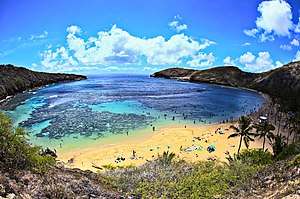 | Tuff cone[65] | East of Honolulu[164] close to Koko Head peninsula[121] |
| Kaʻau | 580,000 ± 120,000,[161] older age estimate is 650,000 by potassium-argon dating[163] | At the head of the Palolo valley[160] | ||
| Kahauloa | 70,000 ± 30,000[42] | Tuff cone[65] | East of Honolulu[164] just southwest from Koko Head.[168] | |
| Kaimukī | 380,000 ± 110,000,[159] older age estimate is 280,000 by potassium-argon dating[163] | Lava cone[169] or lava dome[76] | In Kaimuki, Honolulu[160] on the northern flank of Diamond Head[76] | |
| Kalama | 80,000 - 60,000,[161] older age estimates are 34,000,[117] 30,000 by potassium-argon dating[163] and another is 80,000 ± 50,000[42] | Lava flow with a cinder cone[169] | Northeast of Koko Head[164] | |
| Kalihi | 460,000 ± 70,000,[159] older age estimates are 460,000 - 580,000 by potassium-argon dating[163] | Kalihi volcanics on the crest of the Koʻolau Range,[170] which consist of cinder cones and lava flows.[171] A Kalihi lava flow is found in Honolulu at 12 metres (40 ft).[59] | At the head of the valley of the same name[160] | |
| Kamanaiki | 590,000 ± 20,000[159] | Lava flows[169] | In the Kamanaiki valley[160] | |
| Kāneʻohe | 500,000 ± 90,000,[159] older age estimate is 700,000 by potassium-argon dating[163] | 2 miles (3.2 km) south of the place of the same name[160] | ||
| Kāohikaipu |  | Cone[65] that forms an island[172] | Northeast of Makapuu Point,[164] the easternmost tip of Oahu[173] | |
| Kaupō | 100,000 ± 60,000,[161] older age estimates are 320,000 and 30,000 by potassium-argon dating[163] as well as 32,000[117] | Spatter cone and lava flow[169] | ||
| Koko Crater | 100,000 ± 30,000,[161] older age estimate is 40,000 by potassium-argon dating for the Koko Crater Group[163] | 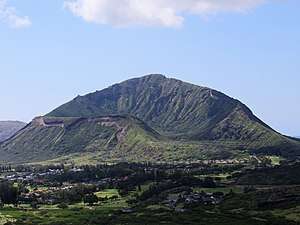 | Tuff cone[65][42] | East of Honolulu[164] |
| Luakaha | 470,000 ± 30,000,[159] older age estimates are 360,000 and 420,000 by potassium-argon dating[163] | Together with Makuku forms the Nuanuu group[174] | At the head of the Nuanuu valley[160] | |
| Makalapa | 470,000 ± 60,000[159] | Maar[65] or crater just east from Pearl Harbor, which drops off steeply from about 30 metres (100 ft) to the shore.[129] | Northwest from Honolulu[160] and directly east from Pearl Harbor[64] (at grounds of United States Pacific Fleet headquarters[175][176]:21) | |
| Makawao | Olomana Peak lies 2 miles (3.2 km) northeast[160] | |||
| Makuku | 400,000 ± 30,000[159] | Together with Luakaha forms the Nuanuu group[174] | At the head of the Nuanuu valley[160] | |
| Mānana | 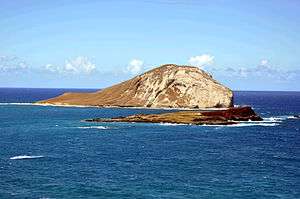 | Tuff cone,[65] also known as Rabbit Island,[34] in Waimanalo Bay.[37] | Northwest of Makapuu Point,[164] the easternmost tip of Oahu.[173] It appears to be formed by two cones, with one crater still preserved.[177] | |
| Mānoa | 200,000 - 70,000[161] | |||
| Maunawili | 790,000 - 780,000[159] | Cinder cone and lava flow[169] | South of Olomana Peak[160] | |
| Mauʻumae | 480,000 ± 40,000,[159] older age estimate is 430,000 by potassium-argon dating[163] | In Kaimuki, Honolulu[160] | ||
| Mōʻiliʻili | 90,000 ± 90,000[161] and more recently 76,000; an older estimate is 67,000[117] | |||
| Mōkōlea | 580,000 ± 90,000[161] | 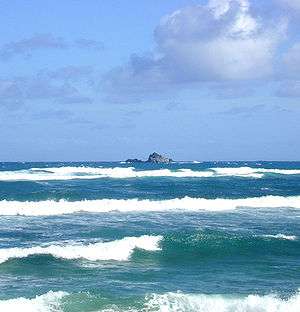 | Also known as Mokapu South[174] or Mokulea[178] | In Kailua Bay[160] |
| Moku Manu | 700,000 ± 80,000[159] |  | An island.[179] | North of Mokapu Point[160] |
| Pali | 640,000 - 600,000[159] | At the Pali road[160] close to the crest of the Koʻolau Range[180] | ||
| Pali Kilo[74] | 400,000 ± 40,000[159] | On Mokapu peninsula[160] | ||
| Punchbowl Crater | 430,000 - 390,000,[159] older age estimates are 300,000 and 530,000 by potassium-argon dating[163] | .jpg) | At the centre of Honolulu[160] | |
| Puʻu Hawaiʻiloa[74] | 450,000 - 420,000[159] | 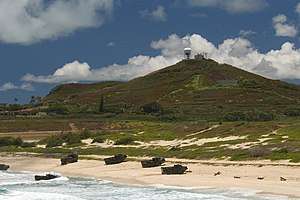 | Located on Mokapu peninsula, it is a symmetric cinder cone with associated lava flows.[181] | On Mokapu peninsula[160] |
| Pyramid Rock | 680,000 ± 100,000,[159] older age estimate is 710,000 by potassium-argon dating[163] | 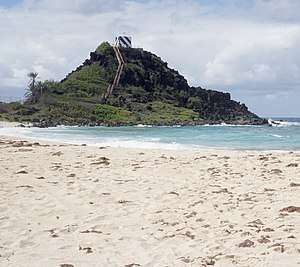 | Located on Mokapu Peninsula,[59] close to Puʻu Hawaiʻiloa.[181] | On Mokapu peninsula[160] |
| Rocky Hill | 60,000 - 40,000[161] or 60,000 ± 70,000[42] | Located close to Punahou School,[182] the vent consists of one main cinder cone and subsidiary vents and lava flows.[183] | At Punahou Street[160] | |
| Round Top | Cone[65] | On the divide between Pauoa and Manoa valleys[164] | ||
| Salt Lake | 430,000[117] | 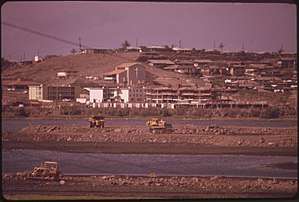 | Tuff Cone[169] | Northwest from Honolulu[160] |
| Sugar Loaf | 76,000 ± 1,000 by argon-argon dating,[184] another estimate for the group is 70,000 by potassium-argon dating[163] | Tuff Cone,[65] cinder cone with ash and lava.[169] The vents that generated the flow are also known as Round Top and Puu Kakea[139] | On the divide between Pauoa and Manoa valleys[164] | |
| Tantalus | 110,000 - 80,000[161] | Tuff Cone[65] | On the divide between Pauoa and Manoa valleys[164] | |
| Training School | 580,000 ± 100,000[161] | Lava flow accompanied by a mudflow[169] | North of Olomana Peak[160] | |
| Ulupaʻu Head | 600,000 - 400,000[185] | 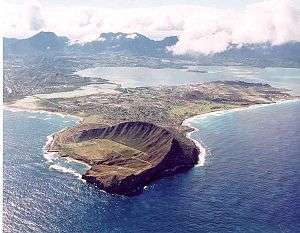 | Ulupau cone is located on Mokapu peninsula,[181] and forms its tip[186] and its highest point.[187] | The tip of Mokapu peninsula[160] |
Notes
- The flexural arch is a structure formed when the crust under Hawaii Island sags and bends under the weight of the growing volcanoes.[25]
- Sometimes described as "Kalihi component"[94] which is found in all Koʻolau volcanic rocks[95]
- Either ancient one or 100 million years old as is the lithosphere beneath Hawaii[97]
References
- "Koolau". Global Volcanism Program. Smithsonian Institution.
- O'Neil, Hedge & Jackson 1970, p. 253.
- Wright & Jackson 1970, p. 405.
- Hay & Iijima 1968b, p. 334.
- Stearns & Vaksvik 1935, p. 64.
- Crandell 1975, p. 4.
- MacCaughey 1916, p. 607.
- Stearns & Vaksvik 1935, p. 98.
- Feldman, C.; Siegel, B. Z. (1 June 1980). Hawaii Energy Resource Overviews. Volume II. Impact of geothermal development on the geology and hydrology of the Hawaiian Islands (Report). p. 32. doi:10.2172/6028655. OSTI 6028655.
- Clague et al. 2006, p. 279.
- Fletcher, C.H.; Romine, B.M.; Genz, A.S.; Barbee, M.M.; Dyer, Matthew; Anderson, T.R.; Lim, S.C.; Vitousek, Sean; Bochicchio, Christopher; Richmond, B.M. (2012). "National assessment of shoreline change: Historical shoreline change in the Hawaiian Islands". Open-File Report 2011–1051. U.S. Geological Survey. p. 31.
- Defense Technical Information Center 1982, p. 3.
- Fisher & Richardson 1950, p. 286.
- "Geology". City and County of Honolulu. Retrieved 14 April 2019.
- Moberly & Walker 1987, p. 6.
- Sherrod et al. 2007, p. 23.
- Doell 1972, p. 2129.
- Stearns & Vaksvik 1935, p. 13.
- Frey & Clague 1982, p. 448.
- Stearns & Vaksvik 1935, p. 63.
- Ohrt, Frederick (1947). "Water Development and Salt Water Intrusion on Pacific Islands". Journal (American Water Works Association). 39 (10): 982. doi:10.1002/j.1551-8833.1947.tb18615.x. ISSN 0003-150X. JSTOR 23349795.
- Wright & Jackson 1970, p. 409.
- Defense Technical Information Center 1982, p. 5.
- Winchell 1947, p. 19.
- Ozawa, Tagami & Garcia 2005, p. 9.
- Ozawa, Tagami & Garcia 2005, p. 10.
- Cox, Doak C. (August 1986). The Oahu Earthquake of June 1948, Associated Shocks, and the Hypothetical Diamond Head Fault (Report). p. 21.
- Clague et al. 2006, p. 281.
- Clague et al. 2006, p. 283.
- Clague et al. 2006, p. 286.
- Clague et al. 2006, p. 294.
- Brill, Richard C.; Langford, Stephen A. (April 1972). "Giant Submarine Landslides on the Hawaiian Ridge: A Rebuttal". Pacific Science. 26 (2): 257. ISSN 0030-8870.
- Morgan, Julia K.; Resig, Johanna M.; Siesser, William G. (March 2006). "Microfossil assemblages on Tuscaloosa Seamount and their constraints on the age of the Nuʻuanu landslide, north of Oahu, HI". Journal of Volcanology and Geothermal Research. 151 (1–3): 270. Bibcode:2006JVGR..151..269M. doi:10.1016/j.jvolgeores.2005.07.031.
- Takasaki & Mink 1982, p. 55.
- Takasaki & Mink 1982, p. 54.
- Dana 1889, p. 96.
- Hay & Iijima 1968, p. 142.
- Sheridan & Wohletz 1983, p. 388.
- Olson & Easton 1976, p. 711.
- Stephens & Bryan 1993, p. 377.
- Branner 1903, p. 313.
- Rottas & Houghton 2012, p. 1683.
- Stephens & Bryan 1993, p. 379.
- Olson & Easton 1976, p. 712.
- Rottas & Houghton 2012, p. 1684.
- Winchell 1947, p. 21.
- Takasaki & Mink 1982, p. 61.
- Hitchcock 1906, p. 471.
- Stearns & Vaksvik 1935, p. 14.
- Stearns & Vaksvik 1935, p. 15.
- Naughton, Lewis & Gramlich 1971, p. 1402.
- Stearns & Vaksvik 1935, p. 123.
- Dana 1889, p. 95.
- Defense Technical Information Center 1982, p. 10.
- Defense Technical Information Center 1982, p. 15.
- Defense Technical Information Center 1982, p. 14.
- Wentworth & Hoffmeister 1939, p. 1555.
- Wentworth & Hoffmeister 1939, p. 1557.
- O'Neil, Hedge & Jackson 1970, p. 254.
- Pollock 1928, pp. 54-55.
- Resig, Johanna M. (1 April 1974). "Recent foraminifera from a landlocked Hawaiian lake". Journal of Foraminiferal Research. 4 (2): 69. doi:10.2113/gsjfr.4.2.69. ISSN 0096-1191.
- Pankiwskyj, Kost A. (April 1972). "Geology of the Salt Lake Area, Oahu, Hawaii". Pacific Science. 26 (2): 243. ISSN 0030-8870.
- Hay & Iijima 1968b, p. 345.
- Hay & Iijima 1968b, p. 348.
- "Koolau". Global Volcanism Program. Smithsonian Institution., Synonyms & Subfeatures
- Wright & Jackson 1970, p. 406.
- Crandell 1975, p. 2.
- Thomas et al. 1979, p. 65.
- Fekiacova et al. 2007, p. 67.
- Takasaki & Mink 1982, p. 7.
- Clague et al. 2016, p. 253.
- Wright & Jackson 1970, p. 427.
- Muhs & Szabo 1994, p. 324.
- Ozawa, Tagami & Garcia 2005, p. 2.
- Dana 1889, p. 97.
- Bamlett, Michael (1990). "Geological excursion guide 7: The volcanism of the Hawaiian Islands". Geology Today. 6 (5): 2. doi:10.1111/j.1365-2451.1990.tb00728.x. ISSN 1365-2451.
- Woollard, George P.; Machesky, L. F.; Strange, William E. (July 1965). "A Gravity Survey of the Island of Oahu, Hawaii". Pacific Science. 19 (3): 353. ISSN 0030-8870.
- Stearns 1939, p. 10.
- Clague et al. 2006, p. 280.
- Fekiacova et al. 2007, p. 68.
- Frey & Clague 1982, p. 498.
- Winchell 1947, p. 20.
- Wright & Jackson 1970, p. 414.
- Wright & Jackson 1970, pp. 415-416.
- Wright & Jackson 1970, p. 420.
- O'Neil, Hedge & Jackson 1970, p. 255.
- Hay & Iijima 1968b, p. 336.
- Hay & Iijima 1968b, pp. 346-347.
- Sheridan & Wohletz 1983, p. 406.
- Frey & Clague 1982, p. 449.
- Fekiacova et al. 2007, p. 78.
- O'Neil, Hedge & Jackson 1970, p. 257.
- Gurriet, Philippe (March 1987). "A thermal model for the origin of post-erosional alkalic lava, Hawaii". Earth and Planetary Science Letters. 82 (1–2): 155. Bibcode:1987E&PSL..82..153G. doi:10.1016/0012-821X(87)90115-4.
- Fekiacova et al. 2007, p. 73.
- Fekiacova et al. 2007, p. 80.
- Clague, Frey & Yang 2003, p. 604.
- Fekiacova et al. 2007, p. 76.
- Clague, Frey & Yang 2003, p. 605.
- Fekiacova et al. 2007, p. 77.
- Takasaki & Mink 1982, p. 2.
- Takasaki & Mink 1982, p. 6.
- Frey & Clague 1982, p. 450.
- Ozawa, Tagami & Garcia 2005, pp. 8-9.
- Doell 1972, p. 2132.
- Naughton, Lewis & Gramlich 1971, p. 1399.
- Hay & Iijima 1968b, p. 339.
- Doell 1972, p. 2130.
- Herrero-Bervera & Valet 2002, p. 84.
- Herrero-Bervera & Valet 2002, p. 85.
- Muhs & Szabo 1994, p. 315.
- Muhs & Szabo 1994, p. 323.
- Ozawa, Tagami & Garcia 2005, p. 3.
- Clague et al. 2006, p. 304.
- Clague et al. 2006, p. 305.
- Ozawa, Tagami & Garcia 2005, p. 8.
- Sherrod et al. 2007, p. 24.
- Clague et al. 2016, p. 274.
- Crandell 1975, p. 5.
- Wentworth & Hoffmeister 1939, p. 1558.
- Stearns & Vaksvik 1935, p. 16.
- Moberly & Walker 1987, p. 5.
- Clague et al. 2006, p. 299.
- Sheridan & Wohletz 1983, pp. 409-410.
- Stearns & Vaksvik 1935, p. 19.
- MacCaughey 1916, p. 609.
- Olson & Easton 1976, p. 716.
- MacCaughey 1916, p. 611.
- Morgan, Charles L.; Jr, James H. Barry; Cruickshank, Michael J. (1 January 1998). "Characterization of marine aggregates off Waikiki, O'ahu, Hawai'i". Marine Georesources & Geotechnology. 16 (1): 79. doi:10.1080/10641199809379958. ISSN 1064-119X.
- Pollock 1928, p. 55.
- Sheridan & Wohletz 1983, p. 404.
- Sheridan & Wohletz 1983, p. 405.
- Winchell 1947, p. 12.
- Rottas & Houghton 2012, p. 1693.
- Rottas & Houghton 2012, p. 1697.
- Olson & Easton 1976, pp. 711-712.
- Skilling, I. P.; Bluth, J.; Simoneau, E. (1 December 2011). "Stratigraphy, paleoenvironment and emplacement mechanisms of the Koko fissure craters, O'ahu, Hawai'i". AGU Fall Meeting Abstracts. 31: V31E–2572. Bibcode:2011AGUFM.V31E2572S.
- Branner 1903, p. 312.
- Clague et al. 2016, p. 259.
- Clague et al. 2016, p. 254.
- Clague et al. 2016, pp. 272-273.
- Hearty, James & Olson 2005, p. 2.
- Hearty, James & Olson 2005, p. 3.
- Hearty, James & Olson 2005, p. 10.
- Hearty, James & Olson 2005, p. 15.
- MacCaughey 1916, p. 610.
- Winchell 1947, p. 6.
- Naughton, Lewis & Gramlich 1971, p. 1403.
- Clague et al. 2016, p. 275.
- Crandell 1975, p. 1.
- Crandell 1975, p. 8.
- Crandell 1975, p. 9.
- Crandell 1975, p. 11.
- Crandell 1975, p. 14.
- Crandell 1975, p. 13.
- Defense Technical Information Center 1982, p. 4.
- Defense Technical Information Center 1982, p. 16.
- Thomas et al. 1979, p. 81.
- Crandell 1975, pp. 6-7.
- Ozawa, Tagami & Garcia 2005, p. 5.
- Stearns 1939, p. 11.
- Ozawa, Tagami & Garcia 2005, p. 4.
- Ozawa, Tagami & Garcia 2005, pp. 4-5.
- Frey & Clague 1982, p. 451.
- Stearns 1939, p. 12.
- Naughton, Lewis & Gramlich 1971, p. 1401.
- Ozawa, Tagami & Garcia 2005, p. 7.
- Winchell 1947, p. 8.
- Hay & Iijima 1968, p. 146.
- Crandell 1975, p. 6.
- Stearns & Vaksvik 1935, p. 103.
- Stearns & Vaksvik 1935, p. 104.
- Takasaki & Mink 1982, p. 52.
- Stephens & Bryan 1993, p. 378.
- Wright & Jackson 1970, p. 411.
- Morison, S.E. (2001). Breaking the Bismarck's Barrier, 22 July 1942-1 May 1944. History of United States Naval Operations in World War II. University of Illinois Press. pp. 194, 12. ISBN 978-0-252-06997-0.
- Siggia, Tim (1984), "Duty in Hawaii: just another day in paradise", All Hands, United States Navy Bureau of Naval Personnel (nos. 804-814), p. 21, retrieved 2020-05-22
- Fisher & Richardson 1950, p. 287.
- "Mokolea". National Geologic Map Database. USGS. Retrieved 14 April 2019.
- Stearns & Vaksvik 1935, p. 120.
- Hay & Iijima 1968b, p. 335.
- Stearns & Vaksvik 1935, p. 99.
- Stearns & Vaksvik 1935, p. 101.
- Stearns & Vaksvik 1935, p. 102.
- Clague et al. 2016, p. 268.
- Hearty, James & Olson 2005, p. 4.
- Stearns & Vaksvik 1935, p. 121.
- Winchell 1947, p. 7.
Sources
- Branner, John Casper (1 October 1903). "Notes on the geology of the Hawaiian Islands". American Journal of Science. Series 4 Vol. 16 (94): 301–316. Bibcode:1903AmJS...16..301B. doi:10.2475/ajs.s4-16.94.301. ISSN 0002-9599.
- Clague, D. A.; Frey, F. A.; Yang, H.-J. (1 April 2003). "Constraints on the Source Components of Lavas Forming the Hawaiian North Arch and Honolulu Volcanics". Journal of Petrology. 44 (4): 603–627. Bibcode:2003JPet...44..603Y. doi:10.1093/petrology/44.4.603. ISSN 0022-3530.
- Clague, David A.; Paduan, Jennifer B.; McIntosh, William C.; Cousens, Brian L.; Davis, Alicé S.; Reynolds, Jennifer R. (March 2006). "A submarine perspective of the Honolulu Volcanics, Oahu". Journal of Volcanology and Geothermal Research. 151 (1–3): 279–307. Bibcode:2006JVGR..151..279C. doi:10.1016/j.jvolgeores.2005.07.036.
- Clague, David A.; Frey, Frederick A.; Garcia, Michael O.; Huang, Shichun; McWilliams, Michael; Beeson, Melvin H. (July 2016). "Compositional heterogeneity of the Sugarloaf melilite nephelinite flow, Honolulu Volcanics, Hawai'i". Geochimica et Cosmochimica Acta. 185: 251–277. Bibcode:2016GeCoA.185..251C. doi:10.1016/j.gca.2016.01.034.
- Crandell, Dwight Raymond (1975). "Assessment of volcanic risk on the island of Oahu, Hawaii". Open-File Report. Open-File Report 75-287. U.S. Geological Survey. doi:10.3133/ofr75287.
- Dana, James Dwight (1 February 1889). "Points in the geological history of the islands Maui and Oahu". American Journal of Science. Series 3 Vol. 37 (218): 81–103. Bibcode:1889AmJS...37...81D. doi:10.2475/ajs.s3-37.218.81. ISSN 0002-9599.
- Defense Technical Information Center (June 1982). "Preliminary Geothermal Evaluation of the Mokapu Peninsula on the Island of Oahu, Hawaii". Unknow. Bibcode:1982pgem.rept...... Archived from the original on 13 April 2019.
- Doell, Richard R. (10 April 1972). "Paleosecular variation of the Honolulu Volcanic Series, Oahu, Hawaii". Journal of Geophysical Research. 77 (11): 2129–2138. Bibcode:1972JGR....77.2129D. doi:10.1029/JB077i011p02129. ISSN 2156-2202.
- Fekiacova, Z.; Abouchami, W.; Galer, S.J.G.; Garcia, M.O.; Hofmann, A.W. (September 2007). "Origin and temporal evolution of Koʻolau Volcano, Hawaiʻi: Inferences from isotope data on the Koʻolau Scientific Drilling Project (KSDP), the Honolulu Volcanics and ODP Site 843". Earth and Planetary Science Letters. 261 (1–2): 65–83. doi:10.1016/j.epsl.2007.06.005.
- Fisher, Harvey I.; Richardson, Frank (1 July 1950). "Birds of Moku Manu and Manana Islands off Oahu, Hawaii". The Auk: Ornithological Advances. 67 (3): 285–306. doi:10.2307/4080918. ISSN 0004-8038. JSTOR 4080918.
- Frey, Frederick A.; Clague, David A. (1 August 1982). "Petrology and Trace Element Geochemistry of the Honolulu Volcanics, Oahu: Implications for the Oceanic Mantle below Hawaii". Journal of Petrology. 23 (3): 447–504. Bibcode:1982JPet...23..447C. doi:10.1093/petrology/23.3.447. ISSN 0022-3530.
- Hay, Richard L.; Iijima, A. (1 January 1968). "Petrology of palagonite tuffs of Koko Craters, Oahu, Hawaii". Contributions to Mineralogy and Petrology. 17 (2): 141–154. Bibcode:1968CoMP...17..141H. doi:10.1007/BF00373206. ISSN 1432-0967.
- Hay, R. L.; Iijima, A. (1968b), "Nature and Origin of Palagonite Tuffs of the Honolulu Group on Oahu, Hawaii", Studies in Volcanology, Geological Society of America Memoirs, 116, Geological Society of America, pp. 331–376, doi:10.1130/mem116-p331, retrieved 14 April 2019
- Hearty, P. J.; James, Helen F.; Olson, Storrs L. (2005). "The geological context of Middle Pleistocene crater lake deposits and fossil birds at Ulupau Head, Oahu, Hawaiian Islands". Monografies de la Societat d'Historia Natural de les Balears (12): 113–128. hdl:10088/213.
- Herrero-Bervera, Emilio; Valet, Jean-Pierre (November 2002). "Paleomagnetic secular variation of the Honolulu Volcanic Series (33–700 ka), O'ahu (Hawaii)". Physics of the Earth and Planetary Interiors. 133 (1–4): 83–97. Bibcode:2002PEPI..133...83H. doi:10.1016/S0031-9201(02)00092-4.
- Hitchcock, C. H. (1 January 1906). "Geology of Diamond head, Oahu". GSA Bulletin. 17 (1): 469–484. Bibcode:1906GSAB...17..469H. doi:10.1130/GSAB-17-469. ISSN 0016-7606.
- MacCaughey, Vaughan (1916). "The Punchbowl: Honolulu's Metropolitan Volcano". The Scientific Monthly. 2 (6): 607–613. Bibcode:1916SciMo...2..607M. ISSN 0096-3771. JSTOR 6171.
- Moberly, Ralph; Walker, George P. L. (1987), Hill, Mason L. (ed.), "Coastal and volcanic geology of the Hanauma Bay area, Oahu, Hawaii", Cordilleran Section of the Geological Society of America, Geological Society of America, pp. 5–10, doi:10.1130/0-8137-5401-1.5, ISBN 9780813754079
- Muhs, D.R; Szabo, B.J (May 1994). "New uranium-series ages of the Waimanalo Limestone, Oahu, Hawaii: Implications for sea level during the last interglacial period". Marine Geology. 118 (3–4): 315–326. Bibcode:1994MGeol.118..315M. doi:10.1016/0025-3227(94)90091-4.
- Naughton, John J.; Lewis, Virginia A.; Gramlich, John W. (1 May 1971). "Potassium-Argon Dating of Holocene Basalts of the Honolulu Volcanic Series". GSA Bulletin. 82 (5): 1399–1404. Bibcode:1971GSAB...82.1399G. doi:10.1130/0016-7606(1971)82[1399:PDOHBO]2.0.CO;2. ISSN 0016-7606.
- O'Neil, James R.; Hedge, Carl E.; Jackson, Everett D. (April 1970). "Isotopic investigations of xenoliths and host basalts from the Honolulu volcanic series". Earth and Planetary Science Letters. 8 (3): 253–257. Bibcode:1970E&PSL...8..253O. doi:10.1016/0012-821X(70)90185-8.
- Olson, E. A.; Easton, W. H. (1 May 1976). "Radiocarbon profile of Hanauma Reef, Oahu, Hawaii". GSA Bulletin. 87 (5): 711–719. Bibcode:1976GSAB...87..711E. doi:10.1130/0016-7606(1976)87<711:RPOHRO>2.0.CO;2. ISSN 0016-7606.
- Ozawa, Ayako; Tagami, Takahiro; Garcia, Michael O. (March 2005). "Unspiked K–Ar dating of the Honolulu rejuvenated and Ko'olau shield volcanism on O'ahu, Hawai'i". Earth and Planetary Science Letters. 232 (1–2): 1–11. Bibcode:2005E&PSL.232....1O. doi:10.1016/j.epsl.2005.01.021.
- Pollock, James B. (1928). "The amount of the geologically recent negative shift of strand line on Oahu". Journal of the Washington Academy of Sciences. 18 (3): 53–59. ISSN 0043-0439. JSTOR 24522667.
- Rottas, K. M.; Houghton, B. F. (1 September 2012). "Structure, stratigraphy, and eruption dynamics of a young tuff ring: Hanauma Bay, O'ahu, Hawai'i". Bulletin of Volcanology. 74 (7): 1683–1697. Bibcode:2012BVol...74.1683R. doi:10.1007/s00445-012-0624-y. ISSN 1432-0819.
- Sheridan, Michael F.; Wohletz, Kenneth H. (1 May 1983). "Hydrovolcanic explosions; II, Evolution of basaltic tuff rings and tuff cones". American Journal of Science. 283 (5): 385–413. Bibcode:1983AmJS..283..385W. doi:10.2475/ajs.283.5.385. ISSN 0002-9599.
- Sherrod, D.R.; Sinton, J.M.; Watkins, S.E.; Brunt, K.M. (2007). "Geologic Map of the State of Hawai'i: U.S. Geological Survey Open-File Report 2007-1089, 83 p., 8 plates, scales 1:100,000 and 1:250,000, with GIS database" (PDF). U.S. Geological Survey Open-File Report 2007-1089.
- Stearns, Harold T.; Vaksvik, Knute N. (1935). "Geology and ground-water resources of the island of Oahu, Hawaii". Journal of Geology. Wailuku, Maui. 44 (7): 536. Bibcode:1936JG.....44..874.. doi:10.1086/624489.
- Stearns, Harold T. (1939). "Geologic map and guide of the island of Oahu, Hawaii" (PDF). USGS. Division of Hydrography of the Territory of Hawaii. Retrieved 14 April 2019.
- Stephens, Robert S.; Bryan, Wilfred B. (1 March 1993). "Coastal bench formation at Hanauma Bay, Oahu, Hawaii". GSA Bulletin. 105 (3): 377–386. Bibcode:1993GSAB..105..377B. doi:10.1130/0016-7606(1993)105<0377:CBFAHB>2.3.CO;2. ISSN 0016-7606.
- Takasaki, K.J.; Mink, John F. (1982). "Water resources of southeastern Oahu, Hawaii". Open-File Report. Open-File Report. doi:10.3133/ofr82628.
- Thomas, D.; Cox, M.; Erlandson, D.; Kajiwara, L. (1 June 1979). Potential geothermal resources in Hawaii: a preliminary regional survey. Phase I, final report (Report). doi:10.2172/5196180. OSTI 5196180.
- Wentworth, C. K.; Hoffmeister, J. E. (1 October 1939). "Geology of Ulupau Head, Oahu". Geological Society of America Bulletin. 50 (10): 1553–1572. Bibcode:1939GSAB...50.1553W. doi:10.1130/GSAB-50-1553. ISSN 0016-7606.
- Winchell, Horace (1 January 1947). "Honolulu Series, Oahu, Hawaii". GSA Bulletin. 58 (1): 1–48. Bibcode:1947GSAB...58....1W. doi:10.1130/0016-7606(1947)58[1:HSOH]2.0.CO;2. ISSN 0016-7606.
- Wright, Thomas L.; Jackson, Everett D. (1 June 1970). "Xenoliths in the Honolulu Volcanic Series, Hawaii". Journal of Petrology. 11 (2): 405–433. Bibcode:1970JPet...11..405J. doi:10.1093/petrology/11.2.405. ISSN 0022-3530.
